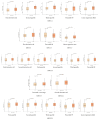Exploring the Relationships Between Antipsychotic Dosage and Voice Characteristics in Relation to Extrapyramidal Symptoms
- PMID: 39111750
- PMCID: PMC11321868
- DOI: 10.30773/pi.2023.0417
Exploring the Relationships Between Antipsychotic Dosage and Voice Characteristics in Relation to Extrapyramidal Symptoms
Abstract
Objective: Extrapyramidal symptoms (EPS) are common side effects of antipsychotic drugs. Despite the growing interest in exploring objective biomarkers for EPS prevention and the potential use of voice in detecting clinical disorders, no studies have demonstrated the relationships between vocal changes and EPS. Therefore, we aimed to determine the associations between voice changes and antipsychotic dosage, and further investigated whether speech characteristics could be used as predictors of EPS.
Methods: Forty-two patients receiving or expected to receive antipsychotic drugs were recruited. Drug-induced parkinsonism of EPS was evaluated using the Simpson-Angus Scale (SAS). Participants' voice data consisted of 16 neutral sentences and 2 second-long /Ah/utterances. Thirteen voice features were extracted from the obtained voice data. Each voice feature was compared between groups categorized based on SAS total score of below and above "0.6." The associations between antipsychotic dosage and voice characteristics were examined, and vocal trait variations according to the presence of EPS were explored.
Results: Significant associations were observed between specific vocal characteristics and antipsychotic dosage across both datasets of 1-16 sentences and /Ah/utterances. Notably, Mel-Frequency Cepstral Coefficients (MFCC) exhibited noteworthy variations in response to the presence of EPS. Specifically, among the 13 MFCC coefficients, MFCC1 (t=-4.47, p<0.001), MFCC8 (t=-4.49, p<0.001), and MFCC12 (t=-2.21, p=0.029) showed significant group differences in the overall statistical values.
Conclusion: Our results suggest that MFCC may serve as a predictor of detecting drug-induced parkinsonism of EPS. Further research should address potential confounding factors impacting the relationship between MFCC and antipsychotic dosage, possibly improving EPS detection and reducing antipsychotic medication side effects.
Keywords: Antipsychotics; Diagnosis; Drug side effects; Parkinsonism.
Conflict of interest statement
Euitae Kim, a contributing editor of the
Figures



Similar articles
-
Neuromotor Adverse Effects in 342 Youth During 12 Weeks of Naturalistic Treatment With 5 Second-Generation Antipsychotics.J Am Acad Child Adolesc Psychiatry. 2015 Sep;54(9):718-727.e3. doi: 10.1016/j.jaac.2015.06.015. Epub 2015 Jul 7. J Am Acad Child Adolesc Psychiatry. 2015. PMID: 26299293 Free PMC article.
-
Exploring Novel Objective Voice Assessment Parameters: A Pilot Study.J Voice. 2025 Jun 7:S0892-1997(25)00205-X. doi: 10.1016/j.jvoice.2025.05.020. Online ahead of print. J Voice. 2025. PMID: 40484739
-
Study on risk factors of extrapyramidal symptoms induced by antipsychotics and its correlation with symptoms of schizophrenia.Gen Psychiatr. 2019 Feb 23;32(1):e100026. doi: 10.1136/gpsych-2018-100026. eCollection 2019. Gen Psychiatr. 2019. PMID: 31179423 Free PMC article.
-
EPS profiles: the atypical antipsychotics are not all the same.J Psychiatr Pract. 2007 Jan;13(1):13-24. doi: 10.1097/00131746-200701000-00003. J Psychiatr Pract. 2007. PMID: 17242588 Review.
-
Extrapyramidal symptoms with atypical antipsychotics : incidence, prevention and management.Drug Saf. 2005;28(3):191-208. doi: 10.2165/00002018-200528030-00002. Drug Saf. 2005. PMID: 15733025 Review.
Cited by
-
Voice-Based Assessment of Extrapyramidal Symptoms Using Deep Learning.Sensors (Basel). 2025 Aug 11;25(16):4968. doi: 10.3390/s25164968. Sensors (Basel). 2025. PMID: 40871832 Free PMC article.
References
-
- Horacek J, Bubenikova-Valesova V, Kopecek M, Palenicek T, Dockery C, Mohr P, et al. Mechanism of action of atypical antipsychotic drugs and the neurobiology of schizophrenia. CNS Drugs. 2006;20:389–409. - PubMed
-
- Blair DT, Dauner A. Extrapyramidal symptoms are serious side-effects of antipsychotic and other drugs. Nurse Pract. 1992;17:56, 62–64, 67. - PubMed
-
- D’Souza RS, Hooten WM. Extrapyramidal symptoms. In: StatPearls [Internet]. Treasure Island: StatPearls Publishing; 2023. Available at: https://www.ncbi.nlm.nih.gov/books/NBK534115. Accessed September, 10, 2023.
Grants and funding
LinkOut - more resources
Full Text Sources

